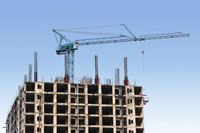Scaffolding structures must adhere to strict standards

Image courtesy of Feelart / FreeDigitalPhotos.net
Deon Bester, Occupational Health and Safety manager at the Master Builders Association of the Western Cape, says the design and construction of any steel tubular scaffold must comply with the South African National Standards (SANS) Code 10085. This contains requirements for design, maintenance, inspection, safety precautions and usage.
To erect scaffolding that conforms to the standards contained within the Code, there are a few fundamental things that need to be taken into consideration. These include the condition of the surface on which the scaffold is to be built, the weather conditions to which it will be exposed, the load that will be imposed upon it and the wind pressure to which it could be subjected.
Four categories
Scaffolding is divided into four specific categories, based on the weight it is able to bear safely per m². The type of scaffolding required must be determined before a design is prepared in order to ensure that it can safely withstand the load it will hold as well as both vertical and horizontal wind pressure. Any scaffolding that does not fall into one of these categories must be designed by a scaffold designer or professional engineer.
All materials to be used in the construction of scaffolding must be inspected by a supervisor before use to determine their suitability and ensure that they conform to the required standards. The area on which the structure will be built must also be inspected. Supervisors are appointed by the employer and must possess the necessary qualifications from an accredited training provider and approved by the South African Qualifications Authority (SAQA). He or she must also comply with the legal construction regulations as well as those contained in the SANS Code.
Structure must be inspected
Scaffold structures may only be constructed by trained, competent scaffold erectors under the direction of a supervisor. Once the structure has been built, it must be inspected and declared fit for use. All scaffold erectors must have undergone the requisite 18 months of classroom and practical training. No untrained people are allowed to alter or remove items from existing safe scaffold structures as the removal of one component would render the entire scaffold structure unsafe and unfit for use.
If the scaffolding is enclosed with sheeting, shade netting or advertising banners, this must be investigated and approved before use since it could affect wind loading. The scaffolding needs to be checked once a week, especially after inclement weather or alterations, with the details of these inspections recorded in a register.
All scaffolding structures must be clearly marked with signage that complies with the requirements of the SANS1186-1 Code to indicate whether it is safe for use and every employee on a construction site must be trained to recognise and obey these signs.